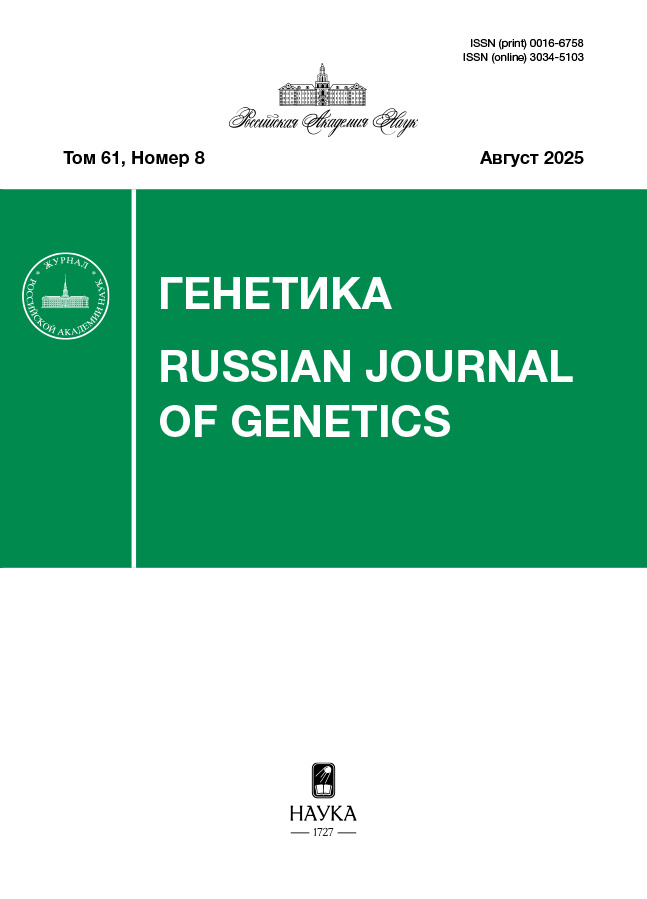Structural Features of the HlyIIR Operator of Bacillus cereus sensu lato
- Autores: Nagel A.S.1, Mayorov S.G.1, Andreeva-Kovalevskaya Z.I.1, Siunov A.V.1, Ivanova T.D.1, Shlyapnikov M.G.1, Solonin A.S.1
-
Afiliações:
- Skryabin Institute of Biochemistry and Physiology of Microorganisms, FRC Pushchino Scientific Centre of Biological Research, Russian Academy of Sciences
- Edição: Volume 61, Nº 8 (2025)
- Páginas: 10-17
- Seção: ГЕНЕТИКА МИКРООРГАНИЗМОВ
- URL: https://cardiosomatics.orscience.ru/0016-6758/article/view/693810
- DOI: https://doi.org/10.31857/S0016675825080028
- ID: 693810
Citar
Texto integral
Resumo
One of the central problems in molecular biology is to establish the mechanism of DNA-protein recognition. A promising model for elucidating the subtle processes of recognition is to study individual stages occurring during specific interaction of the regulatory protein with the operator. Determination of the structure of DNA and nucleotides involved in the interaction of the operator with the repressor allows us to elucidate the pathways of transcriptional regulation of gene expression. Analysis of the regulatory mechanisms of expression of genes encoding bacterial toxins allows us to understand the options for suppressing the toxin genes expression, which will ultimately ensure the creation of a system of regulated synthesis of bacterial toxins. Being study the role of the spatial structure and individual nucleotides of the operator region of the Bacillus cereus hlyII gene in the interaction with the transcriptional regulator HlyIIR, the regions of the operator region of hlyII gene that are essential for the interaction with the HlyIIR repressor were determined. The efficiency of the specific interaction of the HlyIIR repressor with its operator was determined depending on its DNA spatial structure. Using synthetic oligonucleotides with substitutions of individual nucleotides specific nucleotides of the operator were identified that ensure effective specific interaction with the repressor. Thus, changes in the profiles of the efficiency of DNA-protein recognition depending on the structure of the operator were shown.
Sobre autores
A. Nagel
Skryabin Institute of Biochemistry and Physiology of Microorganisms, FRC Pushchino Scientific Centre of Biological Research, Russian Academy of Sciences
Autor responsável pela correspondência
Email: solonin.a.s@yandex.ru
Moscow oblast, Pushchino, 142290 Russia
S. Mayorov
Skryabin Institute of Biochemistry and Physiology of Microorganisms, FRC Pushchino Scientific Centre of Biological Research, Russian Academy of Sciences
Email: solonin.a.s@yandex.ru
Moscow oblast, Pushchino, 142290 Russia
Z. Andreeva-Kovalevskaya
Skryabin Institute of Biochemistry and Physiology of Microorganisms, FRC Pushchino Scientific Centre of Biological Research, Russian Academy of Sciences
Email: solonin.a.s@yandex.ru
Moscow oblast, Pushchino, 142290 Russia
A. Siunov
Skryabin Institute of Biochemistry and Physiology of Microorganisms, FRC Pushchino Scientific Centre of Biological Research, Russian Academy of Sciences
Email: solonin.a.s@yandex.ru
Moscow oblast, Pushchino, 142290 Russia
T. Ivanova
Skryabin Institute of Biochemistry and Physiology of Microorganisms, FRC Pushchino Scientific Centre of Biological Research, Russian Academy of Sciences
Email: solonin.a.s@yandex.ru
Moscow oblast, Pushchino, 142290 Russia
M. Shlyapnikov
Skryabin Institute of Biochemistry and Physiology of Microorganisms, FRC Pushchino Scientific Centre of Biological Research, Russian Academy of Sciences
Email: solonin.a.s@yandex.ru
Moscow oblast, Pushchino, 142290 Russia
A. Solonin
Skryabin Institute of Biochemistry and Physiology of Microorganisms, FRC Pushchino Scientific Centre of Biological Research, Russian Academy of Sciences
Email: solonin.a.s@yandex.ru
Moscow oblast, Pushchino, 142290 Russia
Bibliografia
- Bertram R., Neumann B., Schuster C.F. Status quo of tet regulation in bacteria // Microb. Biotechnol. 2022. V. 15. № 4. P. 1101–1119. https://doi.org/10.1111/1751-7915.13926
- Ramos J.L., Martínez-Bueno M., Molina-Henares A.J. et al. The TetR family of transcriptional repressors // Microbiol. Mol. Biol. Rev. 2005. V. 69. № 2. P. 326–356. https://doi.org/10.1128/MMBR.69.2.326-356.2005
- Orth P., Schnappinger D., Hillen W. et al. Structural basis of gene regulation by the tetracycline inducible Tet repressor–operator system // Nat. Struct. Biol. 2000. V. 7. № 3. P. 215–219. https://doi.org/10.1038/73324
- Budarina Z.I., Nikitin D.V., Zenkin N. et al. A new Bacillus cereus DNA-binding protein, HlyIIR, negatively regulates expression of B. cereus haemolysin II // Mic- robiology (Reading). 2004. V. 150. Pt 11. P. 3691–3701. https://doi.org/10.1099/mic.0.27142-0
- Rodikova E.A., Kovalevskiy O.V., Mayorov S.G. et al. Two HlyIIR dimers bind to a long perfect inverted repeat in the operator of the hemolysin II gene from Bacillus cereus // FEBS Lett. 2007. V. 581. № 6. P. 1190–1196. https://doi.org/10.1016/j.febslet.2007.02.035
- Kovalevskiy O.V., Lebedev A.A., Surin A.K. et al. Crystal structure of Bacillus cereus HlyIIR, a transcriptional regulator of the gene for pore-forming to-xin hemolysin II // J. Mol. Biol. 2007. V. 365. № 3. P. 825–834. https://doi.org/10.1016/j.jmb.2006.10.074
- Schumacher M.A., Miller M.C., Grkovic S. et al. Structural basis for cooperative DNA binding by two dimers of the multidrug-binding protein QacR // EMBO J. 2002. V. 21. № 5. P. 1210–1218. https://doi.org/10.1093/emboj/21.5.1210
- Suzuki M., Yagi N. DNA recognition code of transcription factors in the helix–turn–helix, probe helix, hormone receptor, and zinc finger families // Proc. Natl Acad. Sci. USA. 1994. V. 91. № 26. P. 12357–12361. https://doi.org/10.1073/pnas.91.26.12357
- Crooks G., Hon G., Chandonia J. et al. WebLogo: A sequence logo generator // Genome Research. 2004. https://doi.org/10.1101/GR.849004
- Nagel A.S., Vetrova O.S., Rudenko N.V. et al. Trunca- ted hemolysin II and cytotoxin K2 Forms of Bacillus cereus // Russ. J. Bioorg. Chem. 2024. V. 50. № 5. P. 1800–1806. https://doi.org/10.1134/S1068162024050054
Arquivos suplementares










